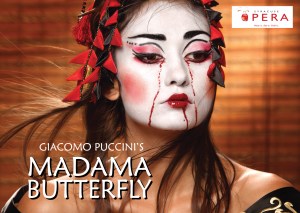Geisha
The Morphing of Madame Butterfly
In Siem Reap there’s a magical little restaurant where the ferns part and the lanterns sway in the tropical breezes. At night, the lights go on and the place twinkles charm. It’s called Madame Butterfly.
I’m not sure when it happened, but through the years the story of Madame Butterfly has become embellished and turned into a Mikado-esque fanfare. If you google “Madame Butterfly”, “Madame Butterfly Geisha” pops up. These two subjects have merged, and in many people’s minds are the same.
Both subjects offer plenty of mystique, glamor and pique our interest in the exotic. I believe it’s a result of this misunderstanding that the two are so often confused. I know. Opera is dramatic. It’s supposed to be. I get that. Puccini’s is one of the most beautiful ever written. Despite the superiority of the score, the opera is still a sentimental favorite, due to the potent mix of tragic love and gorgeous sets; parasols swaying, silk rippling and falling blossoms, all the trappings we’ve come to expect. Those who have attended a performance, or read the backstory know Cho-Cho-san and her horrible ending.
We feel her love for Pinkerton and we go with her on her naïve journey, as she waits, ever faithful, scanning the horizon line for him to return. Touching and poignant. If you’ve done you’re homework, or poked around my blog you’d know the story is largely made up, a myth the Nagasaki Tourist Board shamelessly exploits. It’s based on scant historical evidence. An old photograph and a kimono. The book, Madame Butterfly was published in 1903 by an American lawyer who was influenced by Loti’s famous Madame Chrysanthemum. Are you following me? Because here come’s the geisha connection.
It seems Loti’s story too chronicles a naval officer married to a Nagasaki geisha. Bingo. The novel was so influential in it’s day that it shaped western views of Japan. Or, more precisely of kimonoed Japanese women sitting around all day, emoting for officer lovers. But it did little to promote the truth about the real geisha as artist who studied her craft from an early age. In other words, a story that had no real basis in truth-the Glover House-the photograph of one of his many women wearing butterflies-and a novel became the image we see today; Madame Butterfly the Geisha.
Of course, this is largely due to ignorance and perpetuation of early 20th Century stereotypes of Asian woman as exotic sexual object. To be fair, some includes admiration for La Japonaise style, a craze for everything Japanese, albeit through western filtering at the time.
The geisha and the woman purported to be Madame Butterfly, if she existed at all, are not remotely connected. Period. But through the magic of cinema, novelists and dreamers they will likely be intermingled for a long time to come. And, I guess that’s not such a bad thing as long as people have the opportunity to learn the history and appreciate the craft of the geisha without being confused or sidelined by stereotypes and misinformation. One of the problems is that the geisha community itself, shrinking every decade is closed and guards it’s secrets well. I wonder how they feel about Madame Butterfly, and whether they are annoyed by the morphing of a fictional character into their realm?
It’s still a darn good story that refuses to go away and that’s okay by me.
Ukiyo-e’s Floating World Culture For The Masters

“… living only for the moment, savouring the moon, the snow, the cherry blossoms, and the maple leaves, singing songs, drinking sake, and diverting oneself just in floating, unconcerned by the prospect of imminent poverty, buoyant and carefree, like a gourd carried along with the river current: this is what we call ukiyo.”
Edo 17th century. Shogun ruled with an iron fist. The society was heavily stratified with a land-owning samurai class at the top and the merchants at the bottom. But while the samurai began to decline and grow poorer the merchants grew wealthy. What merchants lacked in respectability they more than made up for in money. They spent that money freely on kabuki; courtesans and other pursuits found in the pleasure quarters. Ukiyo-e embodied a live for today attitude, live while the money is flowing, while the samurai prepared for death. Stark contrast between two cultures.
The merchant class popularized woodblock images, “heroes of Ukiye-o” because they had kobans and ryo to burn on mass consumption, the acquisition and the patronage of artists whose images graced their homes. It’s not surprising that the more conservative government wanted to stamp out the images. They feared that woodblocks would infect the mass culture of Japan with a licentious greed. Waves of artist persecutions came and went, but in the end people loved woodblocks. Merchants wives and daughters copied courtesan style of the day. They imitated flashy kimono and piled their hair high with pincushions of expensive kanzashi hair sticks, which led the government to enact more, futile sumptuary laws.
Everyone wanted to dress like a courtesan and that was the problem.
In the 19th century some of the greatest artists became inspired by the woodblocks of the Ukiyo-e. Van Gogh was rumored to have seen an Eisen woodblock of a famous courtesan when he was painting abroad. The style of the floating world swept opera, musicals, furniture and china, styles that became known as Japonaise. What was largely a hedonistic art form born in a city ruled by a dictator went to Paris.
Some examples of Japonaise art.
Van Gogh’s La Courtisane.
Another charming example of the style, La Japonaise by Wordsworth.
The Barefoot Courtesan
Those who walk barefoot in life, hold their pain within and withstand much.
The foot in Asian culture has long been revered an erotic appendage, but the courtesans who scooted around cold, dark floors, even in the dead of winter were a breed all their own.
The courtesan was a unique creature. She wore flashy layers of silk kimono and padded outer coats called uchikake that rippled as she walked-for a courtesan took five steps to the one everyone else took. She hobbled around engagement to engagement with nothing on her feet. Even during dochu procession, a courtesan walked with her bare feet shoved inside stilted shoes to show her height and her majesty amongst a short-statured culture. The bare foot set the courtesan off from the rest of dull womanhood and was not merely an erotic enticement. The barefooted courtesan showed herself to be tough, resilient, flowering, thriving like beautiful red flowers in a place flowing with tears.
She had to be tough. She came to the brothel as a small child. She was exposed from a very early age to the ugly paying business between men and women. If she was lucky and beauty was on her side, she was groomed by a sponsor to become a courtesan herself.
Exalted beauty had a price. She had an iron-clad contract with her employer, the brothel keeper, that was heavy and one-sided. Everything was charged to her account. She was expected to purchase her clothes and accoutrements for entertaining clients which naturally was designed to keep her in debt until her contract could be bought out by a wealthy daimyo. Sometimes her beauty waned before that could happen. Sometimes she succumbed to disease or death first.
There are no old tayu in Edo. Tayu do not grow old.
The courtesan, a complete creature of the artifice dare not show any concern for ordinary cares, even hunger. The number two rule, after though shall not take non-paying lovers, thou shall not eat in front of a client. Parties and entertainments could well go on for days. Sake flowed, noodles were spilt but the courtesan would never allow one bit of noodle powder to grace her red lip. Men might have thought it was more erotic, the brothel owner decided men did not need to watch women eat. Brothels kept their girls starved and they were allowed to eat to their hearts content one day of the year, on New Years.
Good thing dreams were free.
Of course, very few contracts were ever bought out. The girl had to be extraordinary. Famous, a sensation of her day. If she rose to the very top, she might get out of the life while she was still young enough to enjoy what was left. Before she left the Yoshiwara behind for good, she would wash her feet at the well and walk away free and clear of the quarter and into life with her feet covered as a sign she was retired. Respectable.
Sakuran is Delightful Confusion
A beautiful orphaned girl grows up in a brothel from kamaru to top courtesan amongst female intrigue, jealousy and costumes that demand attention. What’s not to love?
If you haven’t seen the 2009 film bringing the Japanese manga artist Anno’s beloved world of the Yoshiwara to life what are you waiting for?
Kick off your geta, untie your sash this is one spectacular feast for the eye.
Anna Tsuchiya (Kamikaze Girls) plays Kiyoha, a girl traded to a brothel who undergoes a transformation to reach the top courtesan. But she doesn’t want to be oiran. She’s rebellious. She has a dream to see if cherry blossoms are the same as ones outside of the brothel gates. It might sound simple, but courtesans were rarely allowed to cross the great Omon gate for more than a handful of festival days. But while Kiyoha dreams of a life beyond the brothel, grasping elders see her spirited nature as a sign. This girl will rise as a great oiran. The older, house oiran already fears her as her greatest rival in the making. As she grows the tensions escalate to delicious fun.
Rivals aside, and who doesn’t love that, the film explores the courtesan’s peculiar state of being. She’s schooled in the ways to please men but for the love of God, thou shalt not fall in love. To take a lover was the end of a courtesan’s career, a hidden trap that could expose her to pregnancy, blackmail and disease. If a man takes a courtesan to bed he must pay for the privilege. To fall in love was a weakness. To give away favors for free was a disgrace. Dismissal was the price to be paid for disobedience and the contract, thousands of ryo, was due and payable to the brothel upon expulsion. Woe to the courtesan who didn’t steal her heart and was wise in the ways of love; who didn’t wait till the time was right for love after her contract was bought out. This is Kiyoha’s down fall and why we love her so much.
Will Kihoya get to see the cherry blossoms on the outside of the brothel gates and what will she find? You’ll have to watch but trust me this film just has it all. Stunning costumes; allusion and symbolism; terrific cast; amazing cinematography and a fabulous soundtrack. They also nail the figure-eight step.
If you don’t have time to watch the whole thing check out the song below Gamble by Sheena Ringo for a montage of the film.
One Night in Edo with a Courtesan
It’s dusk in the Nightless City, Yoshiwara over by the old Asakusa shrine. The lanterns are blazing along Nakanocho Boulevard and the cherry blossoms are falling.

Two men, a daimyo from the Kando where well-to-do escape stifling heat of summer and Yabo-san, Mr. Bumpkin from the hills passing through Edo are about to cross paths.

The kago drops the daimyo off to the House of Great Muirya-a prestigious brothel where the lawns are manicured into impossibly, charming little gardens and cedar floors lead into a labyrinth of assignation tunnels.
This is not the daimyo’s first time or his second. He’s paid a bundle in ryo just to negotiate a meeting with the high class courtesan. He hasn’t been accepted. She’s late. She didn’t even show up the last time the meeting was requested. He’s donned the inevitable straw hat disguise, so no one knows he’s moving about such an infamous place.
The hat is of course a joke. Many samurai wear the same disguise but it seems a ritual that is tried and true in the Yoshiwara. He’ll give up his daishi and sword at the door before he enters the brothel. They don’t want any trouble, and besides everyone knows he’s here. His name is posted outside. If she accepts him, the room will be sumptuous. He can think of little else. He hasn’t seen her. There’s been drinking games, endless sake, geisha entertaining and he’s getting poorer each time but that’s the brothel’s idea. Make him wait. Spend his money. It’s been months and he’s a man of position and power. But still the courtesan refuses him. He’s determined all the more to have her, at least till his ryo runs out.
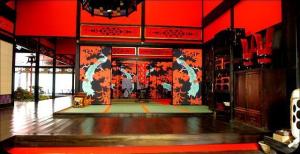
Yabo jingles kobans in his sash. He’s saved a lifetime all for this moment. He has enough for a meeting at the tea house to request a night with the famous courtesan. He wonders if his countrified airs will count against him. He jingles kobans again. He’s not handsome and the courtesan may well turn up her nose. Money will pay for anything, even a night with the girl of his dreams.
The shoji slides and she floats into the room, with a trail of silk and jasmine flowing behind her. The yabo and the daimyo look at each other. Who will she choose?
Kyoto A City in Bloom
To my mind there is nothing so beautiful as the ancient city of Kyoto. The shogun had Edo, but Kyoto was fit for an emperor.
Kyoto is full of stories and ghosts. It has a dash for the dramatic too, with thousands of shrines and temples, it is the sacred heart of the country where a bloodied samurai once hid out in a cabin after an assassination attempt for his part in modernizing Japan.
One of the most famous shines is Fushimi Inari Shrine, a tantalizing spectacle for the eye you’ll want to get lost in. The shrine showcases thousands of jaw-dropping bright torii gates, you wind your way through to get to the shrine. This is one place where the journey really counts.
Kyoto is also home to Gion, the traditional Geiko district. If you hang out, or are lucky you might see the Geisha as she scoots to her engagements around the old city streets.
There are tourist traps in Kyoto like any other city, but if you want to mingle with real Geisha you’ll need to be invited to a prestigious tea house, and if you’re George Bush or a wealthy industrialist you might have a chance, though it won’t guarantee you entry. Yes, it’s that hard.
Fall is one of the best times to see Kyoto. The maple tree is well-cultivated and nothing is more breath-taking than seeing the fiery show of these beauties as they change with the seasons.
Autumn is also a great time to grab a sip of plum sake, and head for Gion for more Geisha-watching, because you’re not important enough to enter the tea house.
Shrines. Geisha. History and bloodied samurai. Yet, nothing says Kyoto like cherry blossoms. Hanami is the very best time to visit Kyoto.
You’ll see lots of Geisha if you go to Kyoto during cherry blossom season, so go and rejoice. Grab your camera, but keep a respectful distance. You’re in Kyoto and you’ll have to be happy with a look on the outside. If you’re David Bowie, you might get into the tea house.
Japanese Woodblocks; A courtesan’s Best Friend
The woodblock was a Chinese import Japan took to her heart. The art existed before moveable type, but arrived late to the island nation. Ukiyo-e artists of the so called floating world flourished during the 17th Century and beyond. The floating world refers to the dominant culture in Edo celebrating beautiful women of the Yoshiwara, kabuki actors, history, and natural landscape.
The most famous artists, Utamaro, Hokusai, Harunobu and Hiroshige created a stir by publishing series dedicated to the most famous courtesans of the day. Tamigeko. Takao. Katsuyama. All sat for woodblock masters and became household names.
There was no better buzz or copy than to sit with a Ukiyo-e master. If a girl was really famous, the woodblocks created a stampede in front of the printer’s store, with no time for ink to dry. They were revered and treasured by men who dreamed of a night with the famous Takao. A sort of Edo Tigerbeat Magazine.
Rivals dared each other to sell out woodblocks faster, the winner declared the most desirable of her day. The brothels loved this free publicity because it drove up the prices of the girls. The woodblocks became collectors items and courtesans rose in the ranks on the strength of her sales alone. It was whispered that a woman who could sell out all her woodblocks, in record time, must be special indeed.
Kabuki actors were also popular topics of woodblocks. They often depicted courtesans themselves in their performances because it was forbidden for a woman to perform kabuki. It was often difficult to tell kabuki actors depicted as courtesans in woodblocks. Can you tell the difference?
A popular form of erotic woodblocks, shunga was enjoyed by men and women during the Edo period. Hokusai published many erotic woodblocks, and the artists supported themselves supplementing their income. Everyone had their stash. It was cheap, widely available and catered to the masses.
“… living only for the moment, savouring the moon, the snow, the cherry blossoms, and the maple leaves, singing songs, drinking sake, and diverting oneself just in floating, unconcerned by the prospect of imminent poverty, buoyant and carefree, like a gourd carried along with the river current: this is what we call ukiyo.” Asai Ryoi
Ikebana Time
The history of structured flower arranging can be dated 500 years back. The roots are obscure but a Buddhist connection is suspected. The first practitioners were Buddhist monks. It was simple in the beginning, only a few tall stems and two shorter stems were used to create the illusion of life in flowers. One did not just place the stems in a special oblong vase, one contemplated in the mind before carefully systemizing a harmonious arrangement.
It wasn’t long before the samurai became avid Ikebana enthusiasts. They brought the lifestyle into the homes of upper class warriors. The sacred alcove, the Tokonoma, a small screen, an incense and candle.
A popular style, the Shoka consists of three main branches, known as “Heaven”, “Earth “, and human.
a Glimpse at the Real Madame Butterfly
I’m cheating a bit in my title. I do realize but I love a good mystery. Take the romantic tragedy of Madame Butterfly. The story is a classic opera. A few movies. Has inspired several books, including my own, The Secret Life of Concubines. Even Madame Alexander made a doll in her likeness.
But I want to know. Who is Cho-Cho-san?
The story is simple enough. Pinkerton, the naval officer arrives on a ship. Meets a beautiful girl, Cho-Cho-san. They fall in love but Pinkerton leaves her behind, and she waits and waits and waits and waits with unshakable faith, he’ll be back.
But it doesn’t go the way she wants. Enter the tragedy part.
Pinkerton returns. He’s surprised to see Cho-Cho-san is not alone, she has a child. A son who is her whole life. In the words of Malcolm McLaren, Pinkerton’s a bounder. He married a Yankee girl. Which can only spell total devastation for Butterfly. She goes ballistic when she learns he has not returned for her as promised, and…he’s brought his wife. They want her child. Butterfly is destroyed.
It’s a wonderful story, and Puccini’s opera is one of my favorite. But was Madame Butterfly real? Depends on who you ask.
Thomas Glover, a Scottish merchant went to seek his fortune in the Meiji era. He worked the tea trade, and ended up on Nagasaki where he opened his own doors. He was half-adventurer, half-international investor. He took an active role in the Boshin War that toppled the shogunate and built the first western house on the island. He won and lost fortunes a few times over but Glover was first and foremost an industrialist, instrumental in aiding Japan’s rise out of feudal darkness.
He met and married Madame Tsuru. They had a son, Thomasburo. Not much is known about her, accept an old photograph where she is wearing the famous kimono adorned with butterflies. No historical evidence exists that she went by the name Ocho-san (Butterfly). Not a shred, other than the kimono. Historians have deduced that Madame Butterfly was a fabrication of the Nagasaki Tourist Board, even going so far as to rename Glover House, the “Madame Butterfly House.”
Who was Cho-Cho-san?
Who inspired one of the greatest Italian operas?
A publicity stunt. An old photograph and a whiff of history. I wonder if Puccini knew that. Somehow, I don’t think he’d care. I don’t care either, I should but it’s a great story. Right?
A Japanese Courtesan’s Beauty Secrets
I read an article today on NBC news that said women obsess about their looks 6 x more than men. Ha! No shock there, we have been trying to make ourselves lovely since Cleopatra donned famous khol-lined eyes to reel in Julius Caesar. Adornments are an important part of culture and a rite of passage that signals to the opposite sex one has passed from childhood.

Ohaguro “Iron Drink”
Crazes come and go. Today, everyone wants bleached out, movie-star sparkly teeth. Therefore, it might seem shocking at first glance, but the history of tooth blackening in Japanese culture is an old and storied one. The practice died out in the Meiji era, 1868-1912, but you can still see Maiko’s and Tayu of today adhering to the practice. Ladies at the imperial court in Kyoto and even ordinary women engaged in blackening their teeth. The allure was related to admiration of black, shining lacquer. Married women were required to blacken their teeth through a mixture of iron and vinegar, mixed with tea powders that would stick to the teeth for days. It was a mark of maturity amongst women, when motherhood and wifely duties were taken up.

So, why would courtesans want to engage in this ritual, I mean they were supposed to be different right? Stand out, be special, hold an air of mystery. Well, according to John Stevenson, courtesan’s of the Yoshiwara used the practice as part of a new courtesan’s coming out ritual, to define her as shinzo-teenage courtesan in training. It may have also protected the teeth, ironically from decay as the heavy kohl seems to have had antibacterial properties for the Egyptians. Black teeth were considered beautiful, so it makes sense that the courtesan would want to add this to her arsenal.
What do you think? Do you think its beautiful? When I was researching Japanese beauty rituals for the sequal to my book, The Secret Life of Concubines, I debated very heavily to add this to the main character’s beauty ritual as she works her way up as top courtesan in the Yoshiwara, unsure how the practice would be received by Western audiences.
An old secret-Nightingale Dung
Like I was saying, kicks come and go and no one really knows what beauty treatments work to stave off age. You can go to a few select spas around the world, not just in Asia, but here in the US and get a Nightingale poo facial massage. Before you scoff at the notion, there maybe gold in them there hills. The mark of true beauty in the Edo period, and before that was white skin. To achieve this, women used a lead-based powder on their face. But there were courtesans so stunning with truly dewy complexions that made men weep. They needed no powders and no cover-ups. To ensure they stayed that way, a lengthy massage was employeed by the brothels to keep their top stars in shape and ensure a graceful aging process. It’s also a known fact that courtesan’s lied about their age, and they could because they looked so good. The nightingale droppings were harvested and added to white clay and water to make a treatment that was hailed for lightening the skin and smoothing out the texture.
The dung contains the amino acid guanine and is rich in urea which encourages the skin to retain moisture. These ingredients give users a boost to the complexion, and a lighter, softer glow. Even Oprah has endorsed the product. Still not convinced? If you wear cosmetics, chances are your already wearing guanine, and its what gives fish scales their iridescent sheen.
I’m curious, and I’m a product junkie so I might try this.


















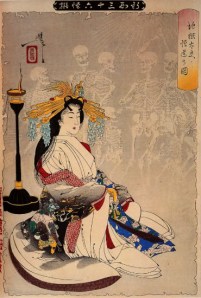

















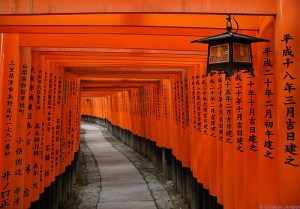







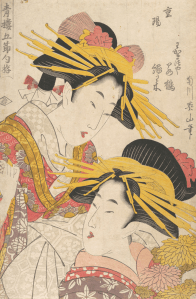
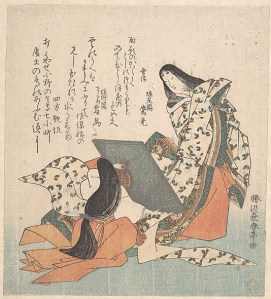



 <
<







